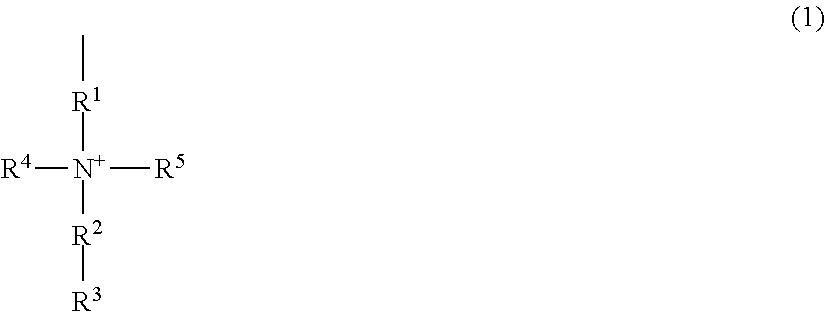Magnetic bead, ligand-binding bead, method for detecting or separating target substance, and method for producing the magnetic bead
- Summary
- Abstract
- Description
- Claims
- Application Information
AI Technical Summary
Benefits of technology
Problems solved by technology
Method used
Image
Examples
synthetic example 1
Synthesis of Magnetic Beads Having Hydroxy Group on Surface
[0168]With 20 g of a 1 mass % aqueous solution of dodecyl sodium sulfate, 2 g of a 75% solution of di(3,5,5-trimethyl hexanoyl)peroxide (“PEROYL 355-75 (S)” manufactured by NOF Corporation) was mixed, and the obtained mixture was finely emulsified by an ultrasonic disperser. This was put into a reactor comprising 13 g of polystyrene beads (number average particle diameter: 0.77 and 41 g of water, and the mixture was stirred at 25° C. for 12 hours.
[0169]Next, 96 g of styrene and 4 g of divinyl benzene were emulsified with 400 g of a 0.1 mass % aqueous solution of dodecyl sodium sulfate in another container, and this was put into the above reactor, and the mixture was stirred at 40° C. for 2 hours, followed by raising the temperature to 75° C., and polymerization was carried out for 8 hours. After cooling to room temperature, only beads taken out by centrifugation were washed with water and dried. These beads were used as nucl...
synthetic example 2
Synthesis of Magnetic Beads Having Atom Transfer Radical Polymerization Initiating Group on Surface (1)
[0176]Into a flask, 10 g of magnetic beads having hydroxy groups on the surface, obtained in Synthetic Example 1, were charged, and 32 mL of dehydrated tetrahydrofuran and 7.5 mL of triethylamine were added under a nitrogen flow and the mixture was stirred. This flask was soaked in an ice bath, and thereto was added 6.3 mL of 2-bromoisobutyryl bromide dropwise over a period of 30 minutes. After a reaction at room temperature for 6 hours, the beads in the flask were separated using magnetism, and the beads were then redispersed in acetone. The magnetic separation and redispersion were carried out another several times, and the beads were then dispersed in a 0.10 mass % aqueous solution of dodecyl sodium sulfate. Br contained in the atom transfer radical polymerization initiating group (2-bromoisobutyryl group) was detected by a fluorescent X-ray analysis.
[0177]As described above, th...
synthetic example 3
Synthesis of Magnetic Beads Having Atom Transfer Radical Polymerization Initiating Group on Surface (2)
[0178]Into a flask, 10 g of magnetic beads having hydroxy groups on the surface, obtained in Synthetic Example 1, were charged, and 32 mL of dehydrated tetrahydrofuran and 0.4 mL of triethylamine were added under a nitrogen flow and the mixture was stirred. This flask was soaked in an ice bath, and 0.2 mL of 2-bromoisobutyryl bromide was added. After a reaction at room temperature for 6 hours, the beads in the flask were separated using magnetism, and the beads were then redispersed in acetone. The magnetic separation and redispersion were carried out another several times, and the beads were then dispersed in a 0.10 mass % aqueous solution of dodecyl sodium sulfate. Br contained in the atom transfer radical polymerization initiating group (2-bromoisobutyryl group) was detected by a fluorescent X-ray analysis.
[0179]As described above, the magnetic beads having the atom transfer rad...
PUM
| Property | Measurement | Unit |
|---|---|---|
| Molality | aaaaa | aaaaa |
| Density | aaaaa | aaaaa |
| Molecular weight | aaaaa | aaaaa |
Abstract
Description
Claims
Application Information
 Login to View More
Login to View More - R&D
- Intellectual Property
- Life Sciences
- Materials
- Tech Scout
- Unparalleled Data Quality
- Higher Quality Content
- 60% Fewer Hallucinations
Browse by: Latest US Patents, China's latest patents, Technical Efficacy Thesaurus, Application Domain, Technology Topic, Popular Technical Reports.
© 2025 PatSnap. All rights reserved.Legal|Privacy policy|Modern Slavery Act Transparency Statement|Sitemap|About US| Contact US: help@patsnap.com



